Prairie Colour
Picture this: You are sitting outside on a grassy slope, overlooking the Vermilion River. You have come to this place to get away from the bustle of everyday life. You notice a giant bumblebee buzzing around you and allow your gaze to follow its flight path. That is when you notice it–purples, pinks, yellows, whites, oranges. The colours all pop out at you, vivid and clear. The colours that fight their way through the grass and dot the landscape that otherwise appears green. They are the colours of the prairie.
The NSWA field technicians are once again back in the field for the summer! The best part of being out in the field every day is the chance to see different plants and flowers that the Parkland Natural Region of Alberta has to offer. On a daily basis we see a variety of plants that will both amaze and surprise the viewer as a true phenomenon of nature.
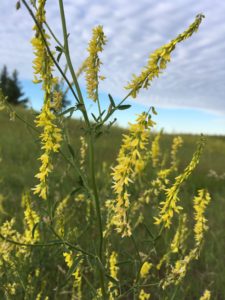
Yellow
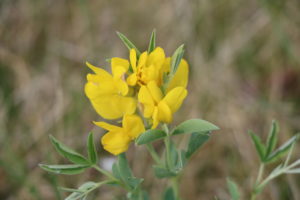
Yellow is the most common colour that we see out in the field, and for that matter, driving down any road! One of the first yellow flowers that we see in the spring is Golden Bean (Thermopsis rhombifolia). This native plant is found in upland areas and is a member of the Pea Family. It is not palatable, so livestock and wildlife will not eat it. However, it carries a beautiful scent on a spring breeze that will awaken your senses.
Another common plant seen everywhere is Yellow Sweetclover (Melilotus officinalis). It was introduced as a forage species for livestock and commonly is seen in pastures, but it also grows on disturbed areas such as ditches. This plant flowers in the later part of June and is great for wildlife and pollinators. As the name suggests, Yellow Sweetclover is a sweet- smelling plant.
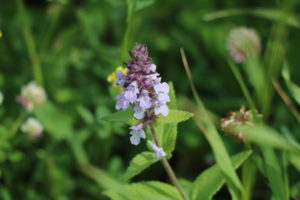
Purple
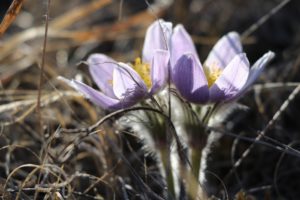
Whereas yellow is the most common colour, purple flowers have to be the most abundant. The Prairie Crocus (Anemone patens) is not only a favorite of mine, but it is also the signal that winter has finally ended, and spring has come. Its pale purple petals and furry stem are the very first bit of colour you will see on a dry prairie slope.
Marsh Hedgenettle (Stachys palustris) is a common plant that we see along stream banks in riparian areas. It looks similar to wild mint, however the flowers are at the stem tip, whereas mint flowers are at each leaf axil. Despite what its common name suggests, Marsh Hedgenettle is not in the nettle family (Urticaceae) and does not have the same stinging hairs as the well-known Stinging Nettle (Urtica dioica).
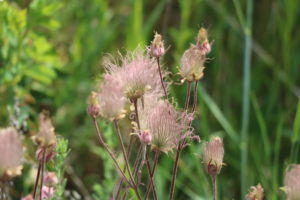
Pink
Prairie Smoke (or sometimes called Three-flowered Avens, Geum triflorum) is a plant that looks like it should be in a fairytale. It commonly is found in dry, open prairie grasslands and blooms from May to June. Due to the ‘feathery’ petals of the flower, prairie smoke was given it’s name because it looks like smoke from a prairie fire when it blows in the wind.
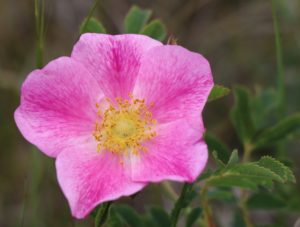
The Wild Rose (Rosa acicularis) has become the symbol of Alberta, as it is a hardy plant that can master all types of landscapes, much like the people of Alberta. There are two types of ‘wild’ roses that are found in Alberta. One is the Prairie Rose and the other the Prickly Rose (more commonly known as the Wild Rose). Though they look very similar at first glance, the Prairie Rose has more leaflets compared to the Wild Rose, and tends to grow more in the southern reaches of the province, whereas the Wild Rose grows more in the central to north regions.
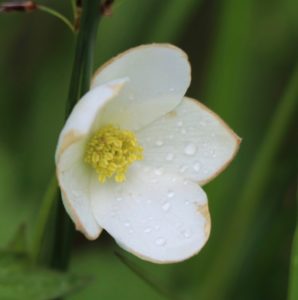
White
White flowers always seem to stand out on the landscape as they provide a stark contrast to the many shades of green that surrounds them. Canada Anemone (Anemone canadensis) portrays delicate white petals with a pale yellow centre. It is found in moist areas and open forests with prominently veined and very distinct leaves. Some sources say that Canada Anemone was used by Aboriginal Peoples to stop nosebleeds and to treat sores and wounds.
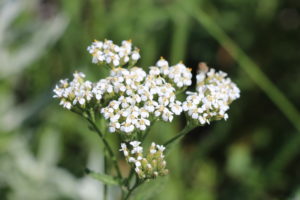
Yarrow (Achillea millefolium) is a common plant found throughout Alberta. The flowers of yarrow are found in flat-topped clusters and the plant is covered in woolly- hairs with a very distinct smell. Like the Canada Anemone, Aboriginals used this plant for its medicinal qualities to help relieve colds, fever and other ailments. Some evidence suggests that yarrow has been used by humans for more than 60,000 years.
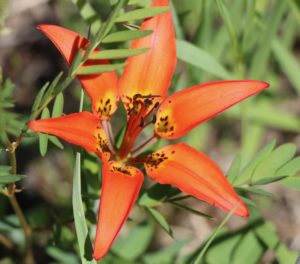
Orange
Orange flowers are not nearly as abundant on the landscape as the other colours, however the few that are here are bright and vibrant. The Western Wood Lily (Lilium philadelphicum) is a beautiful flower known for its showy, reddish orange petals that are seen in prairie grasslands and open woodlands.
Purples, pinks, yellows, whites, oranges. The prairies are full of colour. Next time you take a walk, check your cows, sit on a grassy hill or drive down the highway take a second to look around you. If you look you will be able to see the colours of the prairie.
Photos and content by Grace Turner, NSWA
